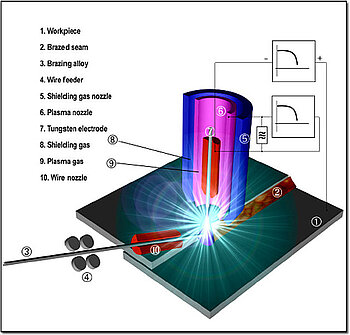With plasma brazing either pulsed or continuous arc currents can be applied. Flat- and vertical-down positions are recommended. In opposite to GMA brazing the filler wire is fed into the arc without any current into the focussed arc. The deposit of the filler wire is therefore (nearly) independent from the heat input. This makes the seam geometry variable within large boundaries.
Plasma brazing with current on the wire is called Plasma hotwire brazing. This variant differs basically only in the additional power provided by another current through the wire. The increased temperature of the filler wire can be used to increase the brazing speed and reduces distortion.
Special requirements to the brazing equipment
For both, standard and pulse mode, power sources with a dropping characteristic are required. The power source is equipped with a ignition device (high-frequency) for a touch less striking of the arc. The high-frequency unit usually strikes the arc between the electrode and the plasma nozzle or between the electrode and the work piece.
Manual applications usually work in a current range from 5-75 A. Mechanized or robotic applications may need up to 250 A. Plasma torches are usually water cooled to carry off the process heat and to provide production adequate service life. The wire is fed from external without a current. Due to the separation of wire feed and arc power it is for instance possible to do repair jobs by remelting without wire.






